Anime Boston 2010: Day 2 in Tweets
Saturday, April 3rd, 2010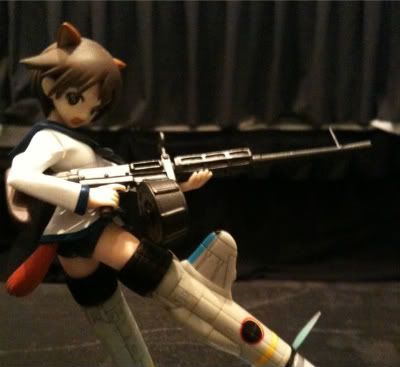
BIGGEST SURPRISE OF THE CON: I bought this figure!
On Site:

BIGGEST SURPRISE OF THE CON: I bought this figure!
On Site:
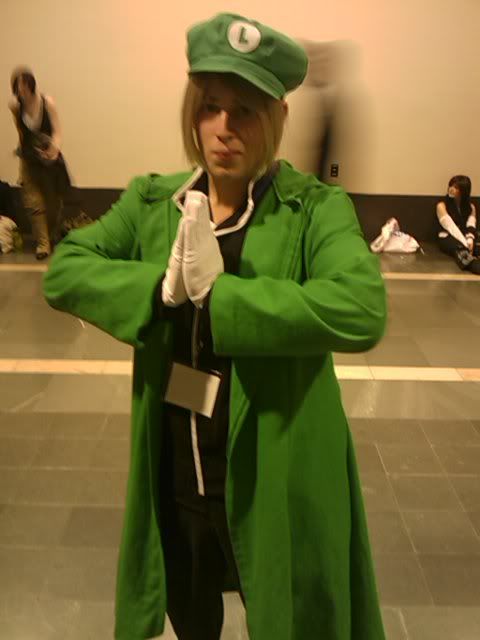
Mama-mia! What a mash-up!
On Site:
Scott from The Anime Almanac |
||
Mike Ferreira from Anime Dream |
Lauren Orsini from Con Chowdah |
|
Ed Chavez from Vertical Inc. |
||
Reni Mimura from ReniReni.com |
 Okay, I guess I need to say a little more about this series than what I posted earlier…
Okay, I guess I need to say a little more about this series than what I posted earlier…
In a fictionalized World War II era world, Earth is being attacked by a mysterious alien race known as the Neuroi. When traditional military forces come up short in combating the threat, the world turns to the girls of the 501th Joint Fighter Wing, the Strike Witches, as their last hope for humanity.
The Witches are an ensemble team of young women from around the world with magical abilities, which periodically manifests itself in the form of animal ears and tails. By attaching the special machinery known as Striker Units to their legs, the girls’ magical powers are enhanced and they also gain the ability to fly. With the Striker Units in place, the girls take to the sky to do battle with the Neuroi in high altitudes.
The first season of the Strike Witches TV series centers around Japanese school girl Yoshika Miyafuji. Because of her magical healing ability, she is recruited by Mio Sakamoto to join the girls of the 501st. The pacifist Miyafuji is reluctant to become a fighter in the war, but when she discovers that her missing father is the inventor of the Striker Units, she goes along with Sakamoto in search of him.
It is no secret that I love Strike Witches. For the past few months, I have been heavily promoting the series on my twitter and blog as FUNimation has been embarking in their tongue-in-cheek “War on Pants” campaign. But my love for the show has been there since it first debuted in Japan nearly two years ago. I named it my #1 anime release of 2008 because it was the first commercially successful anime to be legally available online for a global audience.
However, there is a reason why this became such a big seller in Japan. In a market that has been overflowing with moé titles for years, Strike Witches manages to take the science of fan pandering and make a goddamn masterpiece out of it.
Dude.
They are cute girls who walk around with no pants on.
… and oh yeah, they have animal ears and fluffy tails when they go flying. Some of them are even cat girls!
Do I really need to say any more about it?
* * *
The Good: Everything.
The Bad: Nothing.
Final Verdict: Strike Witches is the best show ever made.
Review copy provided by FUNimation Entertainment.
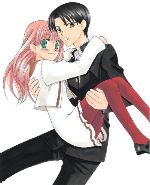 In order to relieve her recently divorced mother of tuition cost, the young Souka decides to transfer from a private high school to the local vocational school. However, when she shows up to her first day of classes, she is shocked to find out that she is the only girl enrolled there!
In order to relieve her recently divorced mother of tuition cost, the young Souka decides to transfer from a private high school to the local vocational school. However, when she shows up to her first day of classes, she is shocked to find out that she is the only girl enrolled there!
There’s a reason why all the girls had dropped out of this tech school. The boys are very tough and fights often break out between the different classes. But amid all this chaos, there is one unwritten law that all the boys abide by, and that is the role of the bancho, or gang leader. Simply put, there is one bancho who rules over the entire student body, and in order to dethrone the leader and take his place at the top of this pecking order, you must knock the crap out of him in a fight.
Needless to say, the poor innocent Souka wants nothing to do with the feuding between the classes or power struggle of the bancho. However, because she is the only girl in school, all of the boys go out of their way to make her feel warm and welcomed. So she decides to stick around the school and eventually becomes friends with the cool Katou-kun. But one day, she accidentally knocks out the school’s current bancho, which means that she takes over as the new gang leader. Can the sweet girl actually rule over this student body of thugs and riffraffs?
My Darling, Miss Bancho is the first (and so far only) comic by shojo artist Mayu Fujikata. While her inexperience is evident on every page of this volume, it ultimately ends up being her greatest strength as CMX Manga releases another winner in this shojo title.
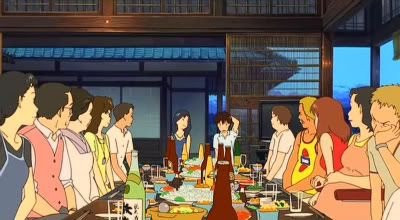
So after a huge mix-up regarding my coverage of the NYICFF this year, I was finally able to catch a screening of the highly anticipated new film from Mamoru Hosoda, Summer Wars, last weekend. Well, pretty much everyone and their mother has seen the film and have written a review of it, and for the most part, the film has been unanimously praised by everyone.
However, I wasn’t quite as wooed over by the film as everyone else was, and when I tweeted this out, I got some peeps asking me to do a review on it. Well, I wasn’t really planning on doing this, so here’s my brief review of Summer Wars using as little spoilers as possible.
Summer Wars is a good movie, it might even be a great movie. But is it as amazing as the hype makes it out to be?
Far from it.
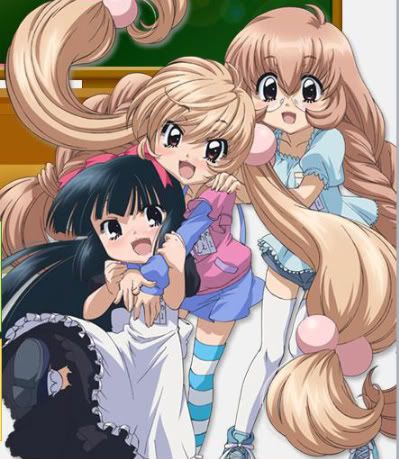
Man, the loli wars just keep on coming. Maybe I need to rename this column “Today in Lolicon” from now on. That’s pretty much all the news that’s worth talking about this week.
Today’s big news is over a proposed bill in Tokyo to ban “virtual” child pornography. The new law would ban the sexual or sexually provocative drawings of children who appear to be under the age of 18 regardless of actual age described in the story. The bill will be voted in committee on the 19th, then it would move up to assembly on the 30th. If it passes assembly, the law will go into effect this October.
This would normally be the point in the post when I would joke about “saving the virtual children” and maybe even providing a quote from a fictional loli girl in order to mock the ridiculousness of this law, but GodLen has already done that. So I’ll just take this one seriously this time.
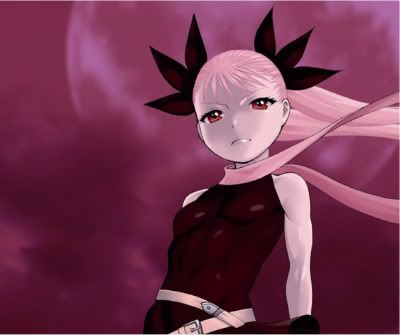
So the big bombshell that was dropped last Friday when FUNimation began its simulcast of Dance in the Vampire Bund was that the American distributor would be censoring scenes in both the online streaming version and DVD release. Although they would not specify what was being cut out, the scenes were obviously centered around the story’s main character, a female vampire in the body of a little child, and her knack for walking around topless with only a black thong on.
[…] after viewing the unedited as well as the Japanese broadcast edit of the series “Dance in the Vampire Bund,” we have determined the series contains controversial elements which, when taken out of context, could be objectionable to some audiences.
With this in mind and with approval of the licensor, we will edit select scenes from the series in streaming and home entertainment release. These are scenes which are inappropriate for U.S. viewing and are not essential to the storyline.
And the whole internet went ape over this.
“How dare they censor our anime!”
“What’s the big deal? The manga was far worse!”
“What about artistic expression?”
“What about freedom of speech?”
“I’m going to boycott this release and any other series FUNimation releases from now on!”
“At first they went for the lolicon, and I said nothing…”
Well, now let me say something.
I have been quite vocal on this blog through out the years against the idea of censorship. In fact, the second post I ever wrote for the Anime Almanac was a long rant in 2005 against VIZ Media for censoring one panel in the comic series I”s. On top of this, I have been a strong advocate against the criminalization of lolicon images in America, since I feel that no work of fiction should be made illegal no matter how vile or disgusting it might be.
But despite this type of background and years of advocating against such things, when this huge news came to light last Friday, I immediately understood why FUNimation had started doing this kind of censorship on their products.
And in fact, I completely support them in doing it.
So why is that? Why do I feel that FUNi censoring images in 2010 is justified while VIZ censoring manga in 2005 was complete bullshit? Am I just being biased towards the one company and not the other?
No, it’s because of the Handley case, people. The Handley case changed everything.
 Kenichi is on the quest to become the world’s mightiest warrior by training in a dojo with six – that’s right, six – different masters teaching him six different fighting styles. And now that he’s gain so much skill in the martial arts, he is being targeted by the leaders of rival gang Ragnarok, who pick fights with him on the streets. But with the help of his female classmate and training partner Miu, the two of them take on any opponent that dare to challenge his six different styles.
Kenichi is on the quest to become the world’s mightiest warrior by training in a dojo with six – that’s right, six – different masters teaching him six different fighting styles. And now that he’s gain so much skill in the martial arts, he is being targeted by the leaders of rival gang Ragnarok, who pick fights with him on the streets. But with the help of his female classmate and training partner Miu, the two of them take on any opponent that dare to challenge his six different styles.
The first season of Kenichi: the Mightiest Disciple completely flew under my radar last year because it did not really look all that interesting with a plot like that. However, it ended up becoming a sleeper hit for FUNimation. In fact, the company has said that the reason why they are releasing this second season is because the fan support has been so huge for this series alone.
So I decided to finally give this series a shot with its second season to see what all this hype could be about. But needless to say, I did not find it all that appealing. If Soul Eater was a throwback of all the awesome anime series I remember watching while growing up, then Kenichi is certainly a throwback to all the mediocre ones.

DearS is a comic in which an alien race of big breasted women (and some pretty boys as well) crash into Earth. Along with highly exposing space costumes, the women wear dog collars around there neck. The collar is symbolic of the fact that their only purpose in their alien life is to find a “master” of the opposite sex and faithful serve under them as a “slave.”
Strawberry 100% is a grade school soap opera where a girl accidentally flashes her strawberry patterned panties at teenage boy when she trips over him. She runs away completely embarrassed, so the boy never gets her name or a good look at her face. But he becomes completely enthralled with the bizarre episode, so he goes on a quest to find the girl with the strawberry panties.
Chu-Bra is the story of a 7th grade girl who is obsessed with women’s lingerie and forms an “Underwear Appreciation Club” with a group of her classmates. Because of this premise, the comic is constantly showcasing its female characters in their underwear, and often in very sexual position as well.
And finally, Kodomo no Jikan is the story of an elementary grade school girl who shamelessly flaunts her sexuality to her male teacher in order to tease him and get him in trouble. Because of it’s portrayal of a little girl in such a way, it has arguably become the most controversial manga title in the past decade, and was even banned in America by Seven Seas publishing.
What do all of these comics have in common?
They were all done by female manga artists.
That’s right, the most offensive, perverted, fanservice-laden, otaku-pandering, female-degrading manga of the past few years have been penned by female manga artists themselves.
How about that, ladies?